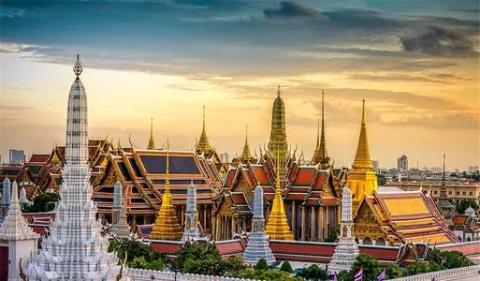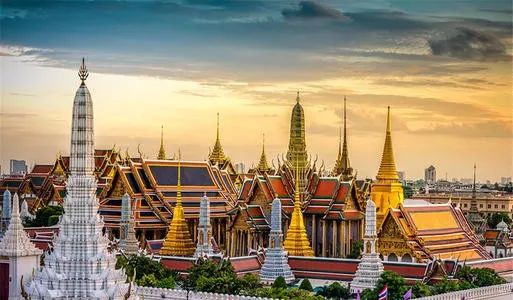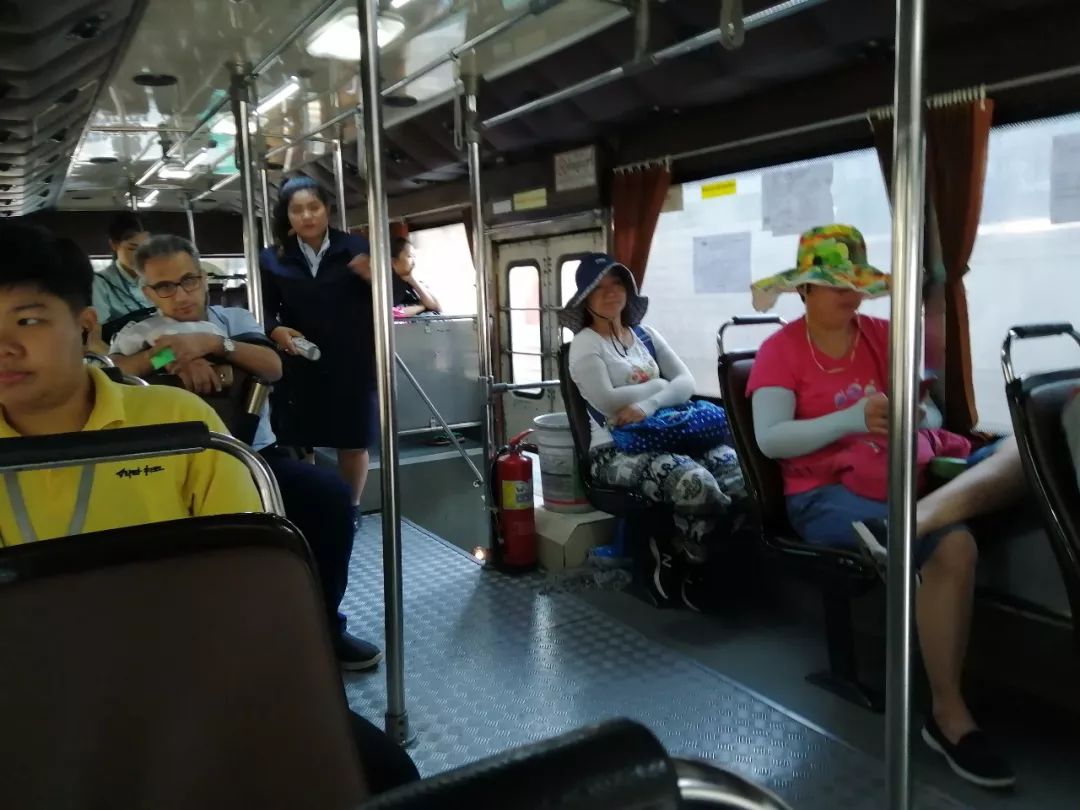

The train from Chiang Mai to Bangkok arrived at Hua Lamphong Railway Station very early. This time I stayed at an OYO hotel near the train station. This hotel also has a Chinese name called "Jinghua Hotel". Next to the train station is Bangkok's Chinatown.
The Chinatown Archway is the symbol of Bangkok's Chinatown

I left my luggage at the hotel and walked along the street to the Golden Buddha Temple. When I went there, it was not yet the time for the Golden Buddha Temple to open to the public. At that time, I thought it was impossible to enter. I continued walking forward and arrived at Longlian Temple next to the subway.
Longlian Temple
Long Lien Temple is the earliest temple built by Chinese immigrants in Bangkok. Its style is obviously different from temples in Thailand. The first level is the Hall of the Four Heavenly Kings, followed by the Main Hall and the Patriarch Hall. The layout of the temple follows the traditional Chinese system.








Before coming to Thailand, I followed the Tourism Authority of Thailand’s Weibo, and happened to see that several newly opened subway stations in Bangkok were in a limited-time free trial operation period, and the Chinese-style Long Lien Temple subway station was specifically mentioned. This time I took the subway from Longlian Temple specifically to see what the MRT Longlian Temple station is like.








It is indeed free to take the subway from Wat Rong Khun to the west. There are subway crew members at the station to hand out disc-shaped subway tickets. This time, five new stations were opened to the west of Hua Lamphong. The BL29 Wat Rong Khun is Wat Mangkon is the first stop, while Sanam Chai on BL31 near the Grand Palace is the third stop.

A short walk away from the subway is the Grand Palace. I have been to the Grand Palace twice. No matter when I come to the Grand Palace throughout the year, I can see Chinese compatriots all over the place. More than 10 million Chinese tourists visit Thailand every year, with an average of 30,000 tourists per day. Most of the tourists who visit Thailand come to Bangkok, and when they come to Bangkok, they must visit the Grand Palace. You can imagine how many Chinese people come here on average every day. This has almost become a Grand Palace scenic spot for Chinese people. This time I didn’t go in. While a family group was visiting the Grand Palace, I went to the nearby Temple of the Reclining Buddha.
Wat Pho
Wat Pho is the oldest temple in Bangkok and the largest temple in Thailand. There is a giant Buddha lying on the altar in the temple. It is the largest reclining Buddha in Bangkok, occupying almost the entire space of the Main Hall. Wat Pho, Temple of the Emerald Buddha and Temple of the Golden Buddha have become Thailand's three national treasure temples.


















After seeing Wat Pho and the Grand Palace, my original plan was to take a boat to Wat Arun. I should have gone to N9 Pier and taken a bus to N8. In the end, I found the wrong place and walked directly to the opposite side of Wat Arun. There is no ferry boat to cross the river opposite the Wang Temple, so we can only take the subway back to our residence. I had dinner in Chinatown at noon, and on the way back I found that the Golden Buddha Temple was open. It was not open in the morning because I went there too early.
Golden Buddha Temple
The Golden Buddha Temple is also one of the three national treasure temples in Thailand. The Golden Buddha among them also has a very legendary history.

The Golden Buddha was discovered about 700 years ago. It is said that the location of the Buddhist temple was originally quite desolate, but later Chinese people gradually settled there. They hired a truck to move a Buddha statue that no one wanted on a barren mountain. During the transportation, the Buddha statue could be disassembled into nine sections. After many twists and turns, after arriving at the temple, a piece of the iron shell of the Buddha body fell off, revealing the shining golden Buddha body inside. After all the iron shells were knocked off, the complete body of the Buddha with shining golden light was exposed. Therefore, it became famous all over the country, and the temple was later named the Golden Buddha Temple. There is also a legend that the Golden Buddha was built during the Sukhothai Dynasty and was later invaded by foreign enemies. In order to prevent the Golden Buddha from being kidnapped by the foreign invaders at that time, patriots covered the Golden Buddha with plaster and buried it in the soil for more than 300 years. It was later unearthed, but because the Buddha's body was covered with plaster, it was not beautiful enough, so it was enshrined in the old temple of Pakai on the bank of the Mekong River. Later, when the temple was renovated into a warehouse, the golden Buddha was accidentally dropped while transporting it. The plaster on the Buddha's body fell off, revealing a lifelike golden Buddha. It became a rare treasure and was transported to Bangkok and enshrined in the temple for believers to worship. Promise. (Baidu Encyclopedia)
This time I saw the Golden Buddha Temple and the Wat Pho, plus the Temple of the Emerald Buddha next to the Grand Palace before. I have been to all three of Thailand’s national treasure temples.




Gleaming golden Buddha



King Power Duty Free Shop
I originally had no itinerary plan that afternoon, but it was too long and I couldn’t just rest, so I decided to go to King Power Duty Free Shop. Use your passport to self-register your information, and you will be given a ฿200 meal voucher whether you buy something or not. It is also good to have a meal without buying anything. The items at King Power Duty Free Shop are not cheap either. Comparing the prices at OREAL, they are more expensive than those sold at the daily necessities store across from Wat Phra Singh in Chiang Mai.






Asiatique Riverside Night Market
The evening arrangement is the Asiatique Riverside Night Market, which is the largest night market in Southeast Asia. Next to the central pier, the symbol is a particularly large Ferris wheel. Some people call this Ferris wheel the "Eye of Bangkok".




The Riverside Night Market mostly sells small commodities, and it is not just a street for snacks like the Ratchada Train Night Market.






Of course, the Hebin Night Market also has a variety of food









Bus stations in Thailand are marked with the central pier as the center. The bus stations to the north from the central pier start with the letter N, while the bus stations to the south start with the letter S. For example, the first stop heading north from the Central Pier is N1, and the second stop is N2. By analogy, the bus station near the Grand Palace is N9, and the bus station where Wat Arun is located is N8. We took the bus back from the night market. What we didn’t expect was that the bus stopped after a few stops. I don’t know why everyone got off the bus and entered the subway station. We had to go to BTS first. Then take the MRT for the return trip.










The second day in Bangkok is a weekend, and the plan for the evening is Amphawa Floating Market. There is no itinerary in the morning. When I was searching for a map, I discovered a Pratunam market that sells clothing. I saw on Google Maps that there are buses that can go directly from the train station to the front of the Pratunam market. Anyone who has studied independent travel in Thailand knows that most people do not recommend taking Thai buses. Because buses in Thailand do not have stop announcements in English, and the stop names do not have corresponding English names, and most conductors do not speak English, it is easy to get on the wrong bus or stop at the wrong stop. However, this experience made me think that Google Maps is pretty good. You can check routes and sites directly on the map.
There are 13 stops in total from Hua Lamphong Railway Station to Pratunam Market, and the fare is ฿15. The price is not expensive, and Thai public transportation is not as unreliable as the legend says.




Pratunam Market
Pratunam Market is the largest clothing wholesale market in Bangkok. It sells all Thai clothing. I think it sells more and more complete types of clothes than Chatuchak Market. If you want to buy local Thai clothes in Bangkok, Pratunam Market is a very good choice.










Oversized short sleeves in XXXXXXXXXXXXXXXXXXXXL

After visiting Pratunam Market in the morning, we took the reverse bus back. In the afternoon we booked a half-day tour of Maeklong Railway Market and Amphawa Floating Market.
Maeklong Railway Market
Maeklong Railway Market is one of Douyin’s Internet celebrity places. It is indispensable to visit here when traveling to Bangkok. When the train comes, the vendors on both sides will temporarily close their stalls and put them out again after the train passes.








The train passes very slowly. You can lean against the walls on both sides and watch the train passing by slowly. It is a rare and interesting experience.
Amphawa floating market
The Maeklong Railway Market is generally not a separate itinerary, but must be combined with the Floating Market, because the Maeklong Railway Market is very far away, located in Samut Songkran, 80 kilometers away from downtown Bangkok. There happen to be two floating markets nearby, one is Damnoen Saduak Floating Market and the other is Amphawa Floating Market. Amphawa Floating Market is only open on weekends. If it is a weekend, the travel combination is usually Maeklong Railway Market and Amphawa Floating Market; on non-weekends, the combination becomes Maeklong Railway Market and Amphawa Floating Market. Damnoen Saduak Floating Market. There are more locals in Amphawa Floating Market and things are cheaper. This place also sells crocodile meat. The crocodile meat tastes like fish, but the meat is slightly harder.












If Amphawa Floating Market is just like this, it is really not as good as Damnoen Saduak Floating Market, but it will be different if you add the boat ride to watch the fireflies at night.
Night view of Amphawa floating market
Fireflies were perched on the branches beside the boat. They looked motionless like lights hanging on the trees, but their brightness was much weaker.
I sat at the very back of the long-tail boat, and the guy driving the boat caught a firefly and gave it to me. Fireflies don't glow in a bright environment, but once you put them in a dark place, they start to shine.
firefly in bottle

Sunday’s itinerary is the Chatuchak Weekend Market, but based on my experience last time, it does not take a whole day to visit the Chatuchak Weekend Market. You can completely arrange other itineraries in the morning. After thinking about it, I still I decided to make up for the missed Wat Arun, and take two stops to the west from Hua Lamphong to get to the MRT subway subway station near Wat Arun.
Temple Arun
Wat Arun, also known as Temple of the Dawn, is a temple commemorating Thailand's 41st king and national hero Zheng Zhao. It was first built in the Ayutthaya Dynasty. It was named Crown Temple at that time and was later renamed Chang Temple. Temple of Dawn is located in the twin city of Thonburi on the west bank of the Chao Phraya River in Thailand. It is a famous temple in Thailand and one of the royal temples in Thailand. The temple is related to the Chinese national hero Zheng Zhao. He once led the army to expel the enemies of Myanmar and save the rivers and mountains. and founded the Thonburi dynasty. (Baidu Encyclopedia)








The pattern on the back of the old ฿10 coin is Temple Arun

Chatuchak weekend market
Chatuchak Weekend Market is located near the intersection of MRT MRT Monchi Station and BTS Skytrain Chatuchak Park Station. You can get here directly by taking the A1 bus from Don Mueang Airport. The Chatuchak Weekend Market is the largest market in Southeast Asia, with more than 10,000 stalls and a size of more than a dozen football fields. The stalls of different products are divided into different areas according to different categories.

Most of the products are similar and shopping doesn’t take that long.








The originally planned itinerary for the evening was the Khao San Road Night Market. The Khao San Road Night Market is more famous, but its scale is not large. I think it is far inferior to the Ratchada Train Night Market. It happened that when I was in Thailand, I saw an article introducing the Sina Karim Train Night Market. I thought that instead of wasting my rare weekend at the Khao San Road Night Market, I might as well go and see what the Sina Karim Train Night Market is like. Son.
Sheena Karin Train Night Market
Sina Karin Train Night Market is about ten kilometers away from downtown Bangkok. It takes 45 minutes if you take the expressway, and one and a half hours if you don't take the expressway. The driver will ask midway if you choose the expressway, you will have to pay additional expressway tolls. When I arrived at Xina Karin Train Night Market , I found a Volcano Spare Ribs restaurant right at the door.




XXL’s volcano pork ribs, the price is ฿599, which is about ¥140



Volcanic spareribs are an internet celebrity food at Ratchada Train Night Market. My original plan was to go to Ratchada Train Night Market to eat it, but since I saw it here, I decided to give it a try. When we saw two people at the next table ordering a portion of pork ribs, we guessed it might be SIZE XL, so the five of us would definitely have to order an XXL size. Shortly after, the ribs arrived. I didn't expect it to be such a big portion. It turned out that the two people wanted L size instead of XL.
The picture still looks small. The XXL ribs are about half a person's height. The five of us couldn't finish the volcano ribs, and we even took a lot of trips back. Later we went to Ratchada Train Night Market and saw the volcano pork ribs there, which were much smaller than this one. Even if you only come here to eat volcano pork ribs, it is definitely worth visiting the Ratchada Train Night Market on the weekends. You can hardly find such a cheap and large one in other places.

The Sina Karim Train Night Market is very similar to the Ratchada Train Night Market. It is also very large and has a lot of delicious food. But because I was so full, I couldn’t eat anything, so I could only look at it.








There are many markets in Thailand that are only open on weekends, such as Chatuchak Weekend Market, Amphawa Floating Market, Sina Karin Train Night Market, etc. If you don’t want to miss these places, time arrangement is particularly important. . Because each itinerary of the travel agency is fixed, and they will not specially arrange time to visit these places that are only open on weekends, the only way is to travel independently.
